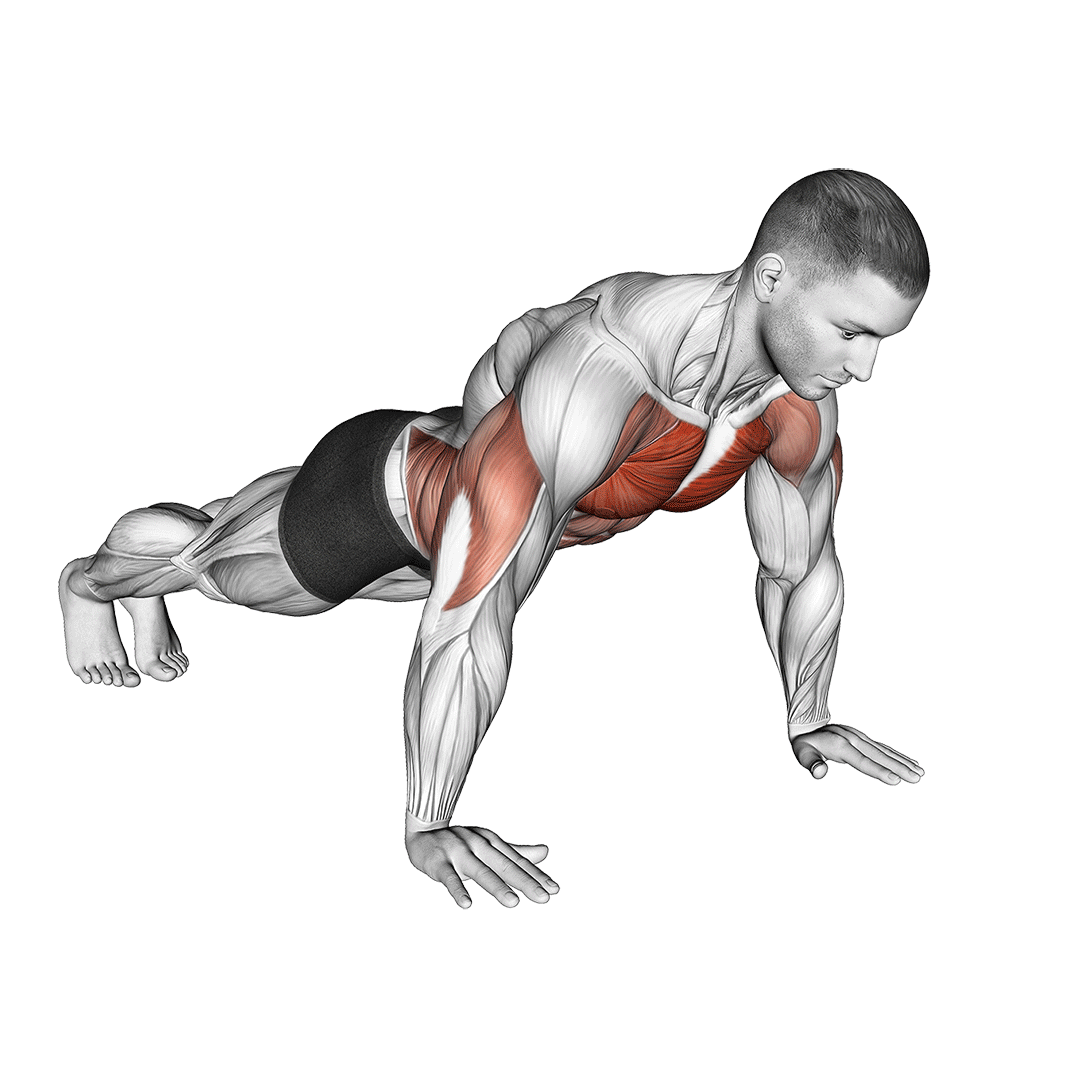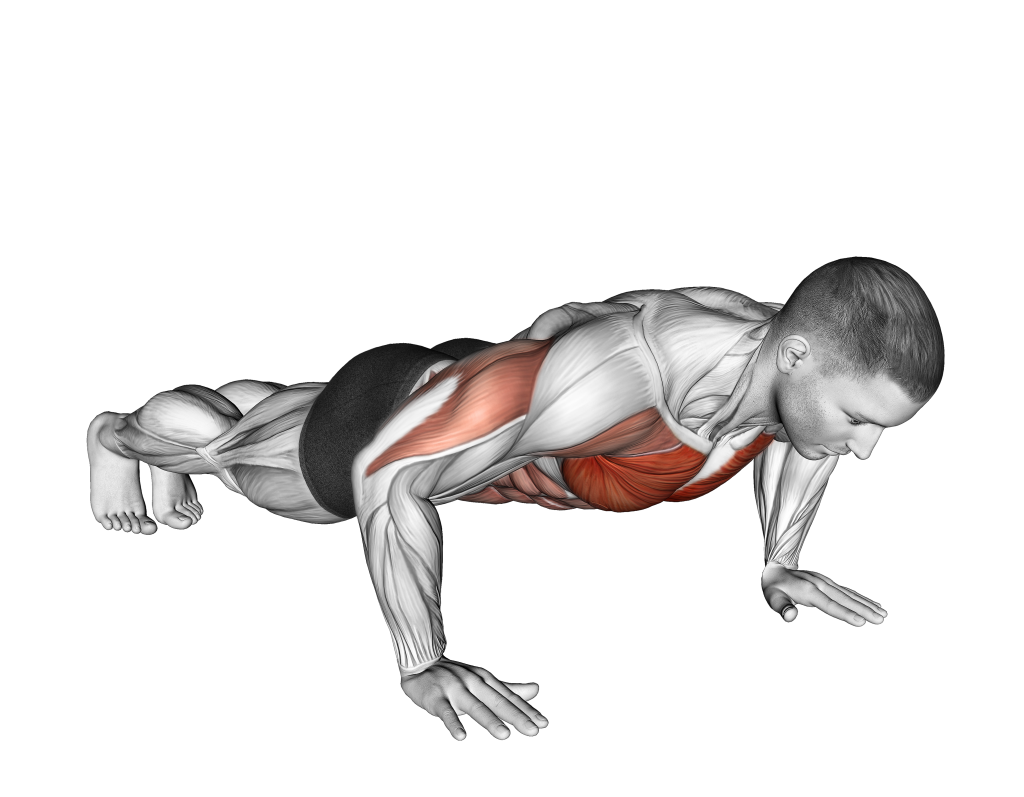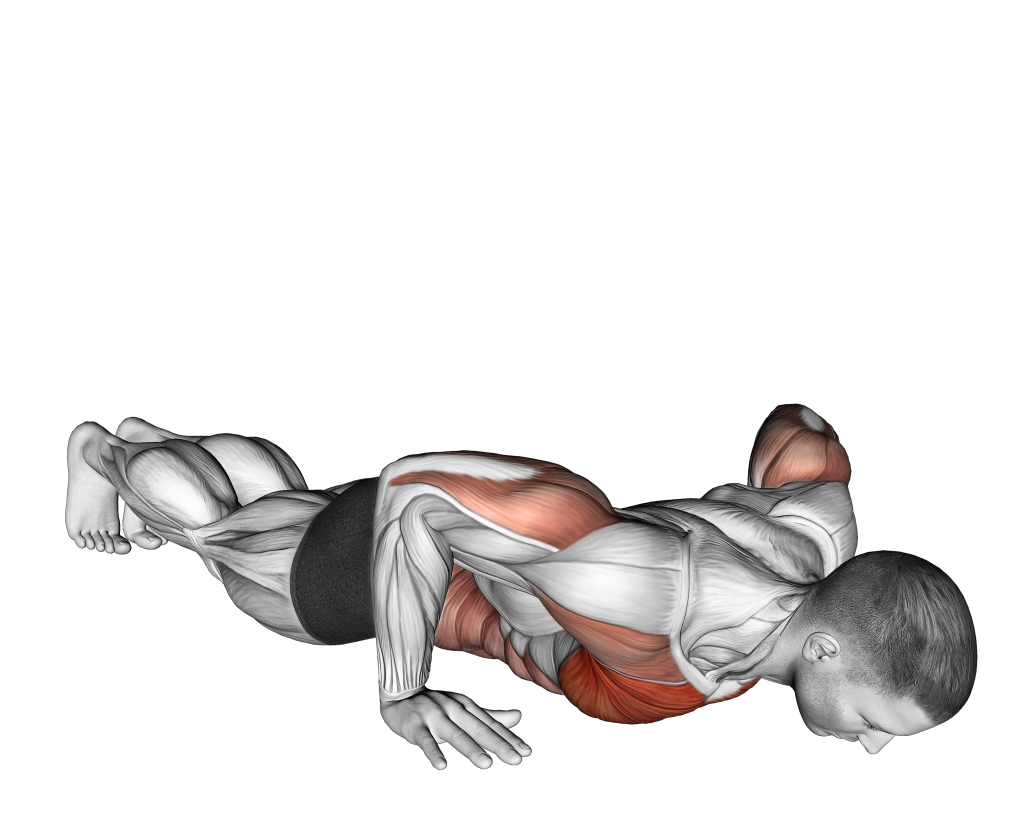Negative (Eccentric) Push-Up: Benefits, Muscles Worked, and More
Among the numerous variations of the classic push-up, there are few as effective for novice exercisers as the negative push-up.
However, despite such effectiveness, many lifters are as of yet unfamiliar with this essential calisthenic movement.
As its name suggests, the negative push-up is a push-up variation with the descending or “negative” portion of each repetition exaggerated in terms of time, meaning that the exerciser will lower themselves to the ground far more slowly than an ordinary push-up would require.
What is a Negative Push-Up?
In more technical terms, the negative push-up is a bodyweight compound exercise that utilizes multiple joints in a manner that recruits numerous muscles across the upper body and core.

Though it isn’t encountered very often in free weight training programs, the negative push-up is nonetheless essential for novice calisthenic athletes or as a strength builder in other bodyweight disciplines.
Who Should Do Negative Push-Ups?
Negative push-ups are the most effective way to improve push-up performance in novices or calisthenic athletes, especially if instability or a sticking point is the cause behind poor push-up performance.
Furthermore, lifters seeking greater pectoral muscle recruitment without the use of more advanced calisthenic movements or employing training equipment can utilize the negative push-up to lengthen eccentric contraction of said pectoral muscles.
How to Do a Negative or Eccentric Push-Up
To perform a repetition of the negative push-up, the lifter will get into a plank stance with their hands and arms parallel to the shoulders at either side of the body.

Then, ensuring the core is contracted and the legs are together, the lifter will slowly bend the elbows and flex the muscles of the chest, lowering themselves to the floor in an exaggerated motion that should last several seconds at the least.

Stretching out the descending portion of this push-up variation is essential, and the entire point of the exercise. Said portion of the repetition should be done in a controlled and conscious manner, and no amount of momentum or “cheating” should take place so as to maximize the benefit of the movement.

For the best benefit, counting out the seconds as the descending phase is being performed can help lifters perform each repetition consistently.
Once the lifter is at the bottom of the range of motion, they will then push-up by straightening the elbows and pressing through their palms. The repetition is completed once they have returned to the starting plank stance with their arms at full extension.
What Muscles are Worked by Negative Push-Ups?
As a compound exercise, negative push-ups will utilize multiple different muscle groups as they are performed - each of which serve their own purpose, with some contributing the majority of the force needed through dynamic contraction while others will simply act as stabilizers of the rest of the body.
Primary Mover Muscles
The main muscle groups used during a negative push-up are the pectoral muscles of the chest, the triceps brachii at the back of the upper arms and the anterior (front-facing) head of the deltoid muscles.
Each of these muscles is utilized in a dynamic fashion and to a level of intensity that secondary or stabilizer muscle groups are not, meaning that they are also the ones that receive the most training stimulus with proper execution of the negative push-up.
Secondary Mover Muscles and Stabilizer Muscles
Though the negative push-up works the primary mover muscles the hardest, it will also recruit the muscles of the medial and posterior deltoid head, the serratus, the core and the glutes in a secondary or stabilizing capacity.
Even if they are not recruited to the same extent or range as the primary mover muscles, these aforementioned secondary muscle groups will nonetheless receive some level of training stimulus from the exercise, and must be factored into training programming so as to avoid fatigue or overtraining.
What are the Benefits of Doing Negative Push-Ups?
Apart from the usual benefits of calisthenic exercise, negative push-ups are also capable of imparting several positive effects that can only really be achieved with it and other push-up variations like it, making the negative push-up a staple in a number of special calisthenic programs.
Significant Push-Up Carryover
The largest benefit and main reason for the inclusion of negative push-ups in training, regularly performing the exercise can cause subsequent performance of conventional push-ups to be greatly improved - allowing for more volume, more stable repetitions and generally better execution of regular push-ups as a whole.
While this can be used as a method for novices to get into performing push-ups for a working amount of volume, it is also an excellent method for more advanced calisthenic athletes to train for a few more push-up repetitions than ordinary training would allow for.
Improved Upper Body Size and Strength
Due to the lengthy time under tension and resistance involved in each repetition of the negative push-up, significant improvements of the upper body may be experienced by the exerciser - especially if paired with other exercises and an adequate diet.
The muscles that will see the most growth in terms of size and strength will be those of the pectorals, triceps and deltoids - though it will be the pectoral and tricep muscles that will grow the most.
Improved Upper Body Stability
Because of the lengthy time under tension and increased need for stability that comes with the negative variation of the push-up, regular performance will cause the various muscles of the upper body to adapt to isometric contraction while under load.
This will lead to greater upper body stability in general, and carry over to other exercises that elicit a similar sort of contraction, such as body weight dips or free weight exercises.
Improved Core Function
Because of the plank position in which the exerciser must hold themselves during negative push-ups, core contraction is also a factor.
With enough time under tension, the muscles of the abs and back will develop to meet these demands, creating greater stability and strength throughout the entirety of the core as a secondary benefit of regular negative push-up performance.
Improved Explosiveness and Athletic Ability
Because of the position and the sudden change in tempo involved in negative push-ups, exercisers will learn to not only produce force in a rapid manner, but also to control it as needed. This is otherwise known as power and explosiveness, and is used frequently in many athletic activities.
As such, the negative push-up is an excellent and highly convenient movement that can directly improve general athletic performance of any athlete - especially those that require upper body explosiveness, such as martial artists or rowers.
Common Mistakes of the Eccentric Push-Up
Despite the similarity between the negative push-up and the conventional push-up, several mistakes relating to the actual execution of the exercise itself can negate the many benefits that it offers.
Descending Too Quickly
The entire point of a negative push-up is to greatly extend the descending portion of an otherwise conventional push-up repetition. This is done to improve the quality of the repetition and build upon the training stimulus already achieved by performing a push-up.
As such, rushing through the descending or eccentric portion of the exercise entirely negates these benefits, and essentially transforms the exercise into a standard push-up, rather than a negative push-up.
Sagging Core or Lower Body
As the majority of push-up variations are performed in a plank position, allowing the core or lower half of the body to sag towards the floor will reduce the amount of resistance placed on the muscles of the upper body, thereby reducing the effectiveness of the negative push-up.
In order to avoid this mistake, properly contracting the muscles of the core and ensuring that the knees are near full extension throughout each repetition should keep the body relatively straight.
Incorrect Hand Positioning
Much like other push-up variations, placing the hands too close or too far from the torso can alter the angle of resistance and place excessive strain on the joints of the arms and shoulders.
If the lifter experiences pain or the inability to complete a full range of motion, it is possible that they need to adjust the positioning of their hands by either setting them wider or closer together.
Furthermore, failing to keep the arms relatively parallel to the shoulders can also produce similar joint discomfort.
How is the Negative Push-Up Programmed?
The negative push-up is performed with far less volume than other push-up variations, as each repetition is long and drawn out so as to elicit the longest time under tension possible.
Such a length of time per repetition will equate to lifters not being able to perform as much volume than they would be able to with repetitions of normal tempo, and as such it is important for the lifter to account for this in their training programming.
Though it will vary between individuals, getting the working volume of their conventional push-up programming and halving it should provide sufficient volume while still avoiding total fatigue with each set.
For example, if the exerciser normally performs push-ups for 3 sets of 20 repetitions each, they may wish to instead perform 3 sets of 10 each.
So long as an RPE of 7-9 is maintained throughout the workout, they are in the optimal range for muscular development.
In Conclusion
Despite the effectiveness of the negative push-up, it is not always the right tool for every situation.
The negative push-up does indeed excel at improving conventional push-up performance, as well as general upper body development in comparison to conventional push-ups - but other areas of benefit such as its capacity to build explosiveness or muscle mass can be surpassed by other exercises as well.
Before adding the exercise to your training program, ensure that it is the right movement for reaching your goals, as well as that you are performing each repetition with appropriate form.
References
1. Harris-Love MO, Gollie JM, Keogh JWL. Eccentric Exercise: Adaptations and Applications for Health and Performance. J Funct Morphol Kinesiol. 2021 Nov 24;6(4):96. doi: 10.3390/jfmk6040096. PMID: 34842737; PMCID: PMC8628948.
2. Dhahbi, Wissem & Chaabene, Helmi & Chaouachi, Anis & Padulo, Johnny & Behm, David & Cochrane Wilkie, Jodie & Burnett, Angus & Chamari, Karim. (2018). Kinetic analysis of push-up exercises: a systematic review with practical recommendations. Sports Biomechanics. 21. 10.1080/14763141.2018.1512149.
